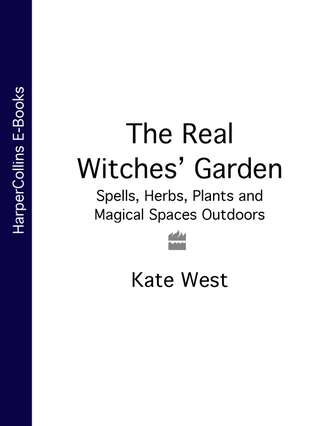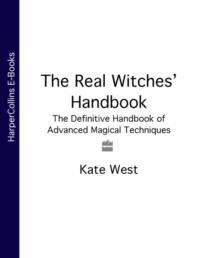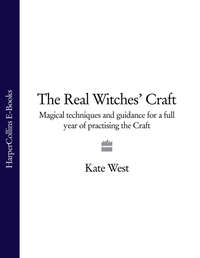
Полная версия
The Real Witches’ Garden: Spells, Herbs, Plants and Magical Spaces Outdoors

THE REAL WITCHES’ GARDEN

KATE WEST

COPYRIGHT

Note to the reader The remedies and techniques in this book are not meant to be a substitute for professional medical care and treatment. They should not be used to treat a serious ailment without prior consultation with a qualified healthcare professional. Neither the publisher nor the author accepts any responsibility for how you choose to handle and use the herbs described in this book.
Element
An Imprint of HarperCollinsPublishers 1 London Bridge Street London SE1 9GF
www.harpercollins.co.uk
and Element are trademarks of HarperCollinsPublishers Limited
Published by Element 2004
© Kate West, 2004
Kate West asserts the moral right to be identified as the author of this work
Text illustrations by Chris Down
A catalogue record for this book is available from the British Library
All rights reserved under International and Pan-American Copyright Conventions. By payment of the required fees, you have been granted the nonexclusive, nontransferable right to access and read the text of this e-book on-screen. No part of this text may be reproduced, transmitted, downloaded, decompiled, reverse engineered, or stored in or introduced into any information storage and retrieval system, in any form or by any means, whether electronic or mechanical, now known or hereinafter invented, without the express written permission of HarperCollins e-books.

Source ISBN: 9780007163229
Ebook Edition © FEBRUARY 2016 ISBN 9780007397280
Version: 2016-01-06
HarperCollinsPublishers has made every reasonable effort to ensure that any picture content and written content in this ebook has been included or removed in accordance with the contractual and technological constraints in operation at the time of publication.
DEDICATION

This book is dedicated to Mags who returned to the Goddess in February 2003. Her friendship and her presence in the Craft are sorely missed.
‘May we meet and know love once again.’
CONTENTS

Cover
Title Page
Copyright
Dedication
From the Author
ONE: A Nature-Based Belief System
TWO: A Space for Living and the Craft
THREE: The Garden as your Sacred Space
FOUR: The Garden for the Goddess and the God
FIVE: The Elemental Garden
SIX: The Garden of Spells and Magic
SEVEN: The Medicinal Garden
EIGHT: The Seasonal Garden
NINE: Tiny and Indoor Gardens
TEN: Plants for Magic
ELEVEN: Lunar Gardening and Plant Care
TWELVE: The Magic Primer
Appendix ONE: What Witchcraft Really is!
Appendix TWO: Terms and Definitions
Appendix THREE: Take it from here …
Keep Reading
Index
Acknowledgements
About the Publisher
FROM THE AUTHOR

Merry Meet!
If I were to ask you to describe a Witch’s garden you would probably envisage climbers growing up the walls of a thatched cottage, a profuse array of colourful and traditional country-cottage-type plants, and herbs to tend all kinds of ailments. But the reality is often nowhere near the dream. For just as Witches appear just like everyone else, so their gardens are as varied as those of other people. They could be large or small; they may be a scrap of concrete, a window box or just the kitchen windowsill. They are often overlooked by neighbours, close to busy roads and shared with children and pets. We describe Witchcraft as a nature-based spirituality, but most of us do not live in an ideal rural idyll with a scenic cottage and enough land, let alone time, to have an established garden full of healing herbs and ‘witchy’ plants. We have busy lives with many commitments and little time to tend and love our herbs and plants. Whilst our Craft seeks to be one with the elements and the land, our personal ‘land’ may be a small scrap of ill-lit soggy soil, a wilderness of rocks and concrete, and full of discarded toys or the evidence of a love of dogs and cats! As Witches we seek to live as a part of the world, not apart from it, and hence we must be realistic. However, we can make the most of what we have, and tend it with a love of the land and of the Goddess, rather than wishing and waiting for some kind of ideal.
Firstly, let me say that this is not a gardening book in the usual way. Here I am not talking about ‘how to garden’; making fertilizer, landscaping, installing water features, cement and decking, but rather how to make the most of your garden. How to use it as a part of your Craft, to make it a sacred place in its own right. A place where you can meet your Gods, where you can grow plants to help you work your magic. A place where you can pre-pay and repay the Goddess and the God, and the land, for what you take and are given. There will be ways of using your garden to enhance your Craft and ways of using your Craft to enhance your garden. Yes, there will be suggestions on what to plant, and how you might like to arrange them, but in the context of working from what you have, rather than creating a whole new outdoors!

Those of you who do have the luxury of being able to make a fresh start, in the fashion of so many modern gardening programmes, will be able to use the ideas here, but those of you with constraints on what you can do will still be able to take the ideas that do fit and discard the rest.
Whilst I have given some plant suggestions I am aware that, with a readership which includes the whole of the English-speaking world, you may not be able to grow the same things. So I have tried to give ideas of the types of plant rather than always being specific. It is my hope that, whatever your kind of soil type, climate, landscape, etc, you will be able to make use of this book. I also hope that you will try to do so using plants native to your area, as these are the ones with a magical connection to your land, your Goddesses and your Gods.
Let me also say that, in my life I have had the pleasure of keeping gardens of all shapes, sizes and conditions. These include a moderate-sized rural near-idyll, a walled but landscaped and shared green patch, many windowsills, 30 square feet of shaded concrete in an area of heavy industrial pollution, a landscaped, gravelled and decked modern travesty of the concept of contact with the earth, and just recently over 180 square metres of untended land given over to thistles! I’ve also worked in gardens where the concept of natural growth has been allowed to run riot, those with enough clay to start a decent-sized pottery, others where the half inch of topsoil covers several tons of concrete and rubble, and even one where the soil was made of, just for once, real growing-type earth! I’ve also shared my garden with dogs, cats, ardent sunbathers and various other life forms.
In this book I hope to incorporate ideas for all types of garden, or growing area, in ways which are compatible with having a full and busy life. Ways of being at one with the land, of sharing it with our near and dear, and still being able to work it in honour of the Goddess and the God. I will include lists of plants and herbs, not so that you can rush out and buy them all, but so that you can choose those which are most applicable to your life, your needs and your Craft.
And just as you can use your garden to celebrate and enhance your Craft, so too you can use magic to enhance your garden. Not everyone, not even those who practise the Craft, is blessed with ‘green fingers’, so here I shall also look at the magics you can work to enhance your ‘green life’: the seasons and times for the best results; spells for sowing, planting and growing, to protect delicate plants, to deter pests and even to influence the weather a little; the Goddesses and Gods who might look more favourably on your piece of the earth. This book is not intended to be the ultimate answer to all your gardening queries, but rather a starting point to blending what you have with what you would like.
As with all the other Real Witches’ books this one is written for real people with real, busy lives who probably don’t have huge amounts of time or money to spend on their gardens but who still want to become closer to the earth. Even if you have no interest in the Craft at all I hope that this book will be of interest to the gardener who seeks a more natural approach to what is, for some, our only work with nature.
Blessed Be
Kate

ONE A NATURE-BASED BELIEF SYSTEM

I call on Earth to bind my spell, Air to speed its passage well. Bright as fire shall it glow, And deep as ocean’s tides shall flow. Count the elements fourfold, For in the Fifth the spell shall hold. Blessed Be.

Why Witches and gardening? Witchcraft is often described as a nature-based spirituality but what does that mean? Well, early Witches would have worked and tended the land, cared for and healed the people and the livestock. Their daily lives and their magical work would have been for the prosperity and the future of their community. Indeed, it is in part from this that the traditional festivals, the Sabbats, came about. For in amongst the meanings of those festivals is a strong and continuing link to the Wheel of the Year and the seasons which form its basis. For me this was one of the key attractions of the Craft.
One of the ways of looking at the Sabbats is to refer them directly to the passage of the seasons. Very simply we can say that:

Samhain (31 October) marks the start of the resting season and is the harbinger of Winter whilst Yule (21 December) marks the onset of that season. Imbolg (2 February) brings the first buds and shoots rising through the frozen earth as a promise of the Spring which begins in earnest at Oestara (21 March). Beltane (1 May) when the hawthorn blossoms presages Summer and Litha (21 June) marks its beginning. Lughnasadh (1 August) is the first of the harvest, which reaches its height at Madron (21 September), the start of Autumn.

In the Craft we refer to the Sabbats collectively as the Wheel of the Year. In addition, each of these festivals is linked to the yearly cycles of the Goddess and the God. The Triple Goddess moves from Mother to Crone at Samhain, from Crone to Maiden at Imbolg, and from Maiden to Mother at Beltane. The God as her Consort moves alongside her through these changes as well as being the Oak and Holly Kings which preside over the lightening and darkening halves of the year from Yule to Litha and Litha to Yule, respectively.

Not only do we celebrate the passage of the seasons but we draw our magical energy from them; Spring is a time of beginnings, Summer a time of development, Autumn the season of reaping and Winter is the time of rest. Of course from an agricultural perspective, that same seasonality tells us when to sow, tend, harvest and rest the soil. Whether from the perspective of the Witch or that of the gardener, the cycles which Witches celebrate as the Wheel of the Year and the phases of the Moon link everything together. There is a proper time for everything, and everything has its season.
The Magics that Witches work now, as in the past, draw their energies directly from the elements of Air, Fire, Water and Earth, all of which are required to create growth and which, when imbued with the fifth element of Spirit, form the foundation of the Craft as well as our magic. Even the most non-natural magic, such as a working to keep your car on the road, derives its power from the energies of the elements. As the spell at the start of the chapter states, the elements are the key to working magic. Without true knowledge and understanding of them it is not possible to work effective magic or to be an effective Witch. And there is no simpler or more natural way to gain that knowledge and understanding than by working with the elements in their most immediate form. For Witches, these are not just the external elements as seen in nature – wind, sun, rain and soil – but also the way those elements are part of ourselves and everything we do. Air is our thoughts, Fire our passions and enthusiasms, Water our emotions and Earth our physical selves. Spirit is the essential ‘self’ as well as the Goddess and the God both within and without. For us to understand and care for ourselves and each other, to develop and grow as individuals, and to work the magics which enhance the lives of our loved ones and our own community, we must harness and balance these elements, both within and without. This is a path of personal exploration, understanding and development which Witches use in all aspects of their daily lives, but perhaps nowhere more so than in their tending of life, whether it be in plants and the soil or in their relationships with family, friends and their wider community of the Craft.
The fifth element of Spirit is personified in the tales, legends and stories of the Goddess and the God, so many of whom are in turn linked to the fertility of the land, the crops, animals and people. From Amalthea, Goddess of plenty, to Zisa of the harvest, the Goddess is inextricably linked to fertility and growth. In her Lunar cycle of Maiden, Mother and Crone we think of her as planting, tending and reaping the life of the people, animals and the land. The God too holds these roles, the Horned God and the Corn King being probably the most obvious examples. There are Gods and Goddesses of sowing and planting, reaping and gathering, and of every kind of plant and animal, from belief systems of almost all times around the world (see here for some of these). Actually getting into contact with the elements and the soil brings special benefits in terms of direct contact with the Goddess and the God. Nowhere can you be closer to your Gods than when you are in touch with the life force that flows through the land than when you experience the elements in action, and when you can see the results of their magic which is the life of the land. And nowhere can you come to a greater understanding of the cycles of life, death and rebirth than when working with nature.
One of the other traditional key skills of the Witch is that of herbalist and healer. Witches have long been respected for their knowledge of healing plants and herbs, and many of these ancient remedies are being reintroduced into our daily lives now that the remedies of aromatherapy, homeopathy, etc, are becoming more readily available. Most practising Witches and other herbal therapists know, however, that these remedies are always better when they can be home-grown. And this is just another of the reasons why even the most urban of Witches feels the need to have some kind of practical connection with the earth.
There is another facet of the Craft which links practising Witches to the land and that is in the often forgotten relationship between the practise of magic and the payment for it. As the magic of Witches is worked in balance with the energies of the elements, as well as our personal energies, we must also look to returning something in kind. This is not just a question of repaying what we have been given, i.e. when the magic works, but should also take the form of pre-payment for what we might seek in the future. Whilst this can take the form of tending for the people in our lives and generally upholding the principles of the Craft, many Witches, myself among them, advocate actually working towards repaying nature itself. As I have mentioned in my other books, you could go to a local park or beauty spot and remove the debris and litter left by others, put food out for wild birds, or support an animal charity. But one of the most effective ways is to work the soil and to tend plants. Whilst you could do this in a local park or beauty spot, it is far more immediate and personally satisfying if you can do it in your own space, even if that space is restricted to a couple of pot plants on the windowsill.
But Witches do not just think of the tending of the garden in connection with the Craft. We use our gardens for the practice and enhancement of it. If we are fortunate and not too overlooked, we will be able to hold our Sabbat and Esbat (Full Moon) Rituals there. Casting the Circle outside, amongst the living reality of the Divine, adds a special dimension to our celebrations and workings. It enhances the magic. Even if we cannot practise obvious Rituals in the garden, we can still work our magic there; planting and growing spells, using the remedies that nature provides. We also use our gardens for contemplation, meditation and to grow closer to our Gods. And we find that, through being active and out there on the land we learn more about our Craft, and about healing not only the physical, but also the emotional and spiritual ills in our lives. Furthermore, being outside gives us the opportunity to get to know and understand more about the other living things we share our world with. Through observing the life around us, even if it’s only a few sparrows and pigeons, we get to appreciate the natural cycles and rhythms in our own lives.

The aspects of the Craft covered in this book are those which relate directly to the care and use of the garden. For those of you for whom this is your first book on Witchcraft there is a fuller introduction and a selection of recommended reading in the appendices at the back of this book. Otherwise, let us move on to see how your garden can enhance your Craft and how the Craft can enhance your garden.

TWO A SPACE FOR LIVING AND THE CRAFT

For many people the garden is the place where they go on the sunnier days of the year. It is a place for occasional barbecues, to have a drink with friends, perhaps to sunbathe or to banish the children when they get too noisy in the house. A few use it to grow herbs and perhaps vegetables for the kitchen. Many will use it to dry laundry, store bicycles and other outdoor equipment. For a Witch, the garden is all this and more. It is our piece of earth, our contact with nature, with the Goddess, the God and the Elements. It is where we grow healing herbs and plants to incorporate into our natural remedies and where we grow the sometimes quite toxic ingredients for inclusion in our incenses and magical spells. It is where we make payment for our magics and where we seek to do our part to enrich the cycle of life and living. It is where we honour the Goddess and the God in the most practical way we can, by tending their creation. It is where we work our Rituals to honour them and where we can work magics in their name, and also where we come to know and understand them through meditation and relaxation. It is where we can actually experience the cycles of the seasons and find the natural indicators for the Sabbats, where we can observe the phases of the Moon and where we can really get to know and understand the cycles of life, death and rebirth. In all of this it is also a place where we recharge our batteries, drawing energy from the earth itself and from our experience of the elements and their part in the rich pageant of growth. The Witches’ garden can also be where we seek to preserve endangered plants and provide a refuge for wildlife. To a Witch, the garden is more than an outdoor room, it is a permanent Sacred Space in its own right, even when being used to hang the washing or amuse the young.

The first thing you need to do is to work out what you really have, what you want and need from it, and what you actually can do. Yes, I currently have a reasonable-sized garden but this is a rented property and so, because it is not truly mine, there are limitations on what I can and cannot do to it. I cannot cut down any trees, move the drive, nor replace the gravelled surface with the thyme and chamomile lawn I would so dearly love to have. Furthermore, I have a young son, so anything I do has to respect his need for a play area, or accept the devastation that a quick game of football might do to my carefully hatched plans! You also almost certainly have constraints on what you can do. These may be like mine, imposed from outside, or they might be the views of other family members, those of nature herself or personal ones like the amount of time and effort you can afford to expend. However, whatever the limitations there is always some kind of way around them. So let us look at some of these issues and some of the potential solutions.
WHAT DO YOU REALLY WANT TO USE IT FOR?





